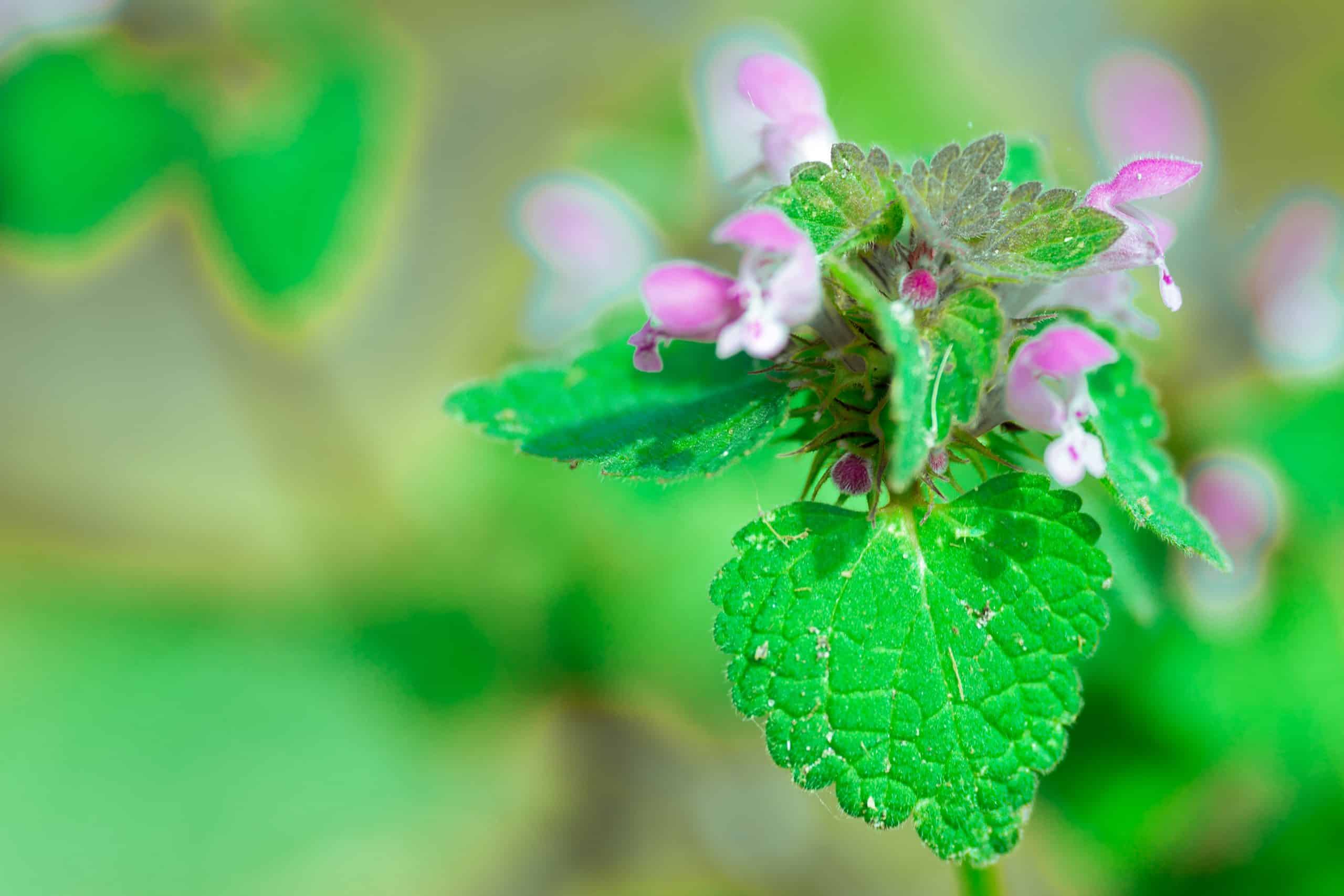In the world of herbs, few possess the versatility and hidden benefits of purple dead nettle. Often overlooked, this unassuming herb carries a rich history and a modern relevance that extends from nutrition to medicine.
Join us as we uncover the nutritional richness, medicinal potential, and culinary charm of purple dead nettle, exploring its diverse applications and ecological contributions. This article aims to reveal the hidden wonders of this herb, offering a concise guide to the many facets and benefits of purple dead nettle.

What Is Purple Dead Nettle?
Purple dead nettle, known scientifically as Lamium purpureum, is a versatile herbaceous plant that belongs to the mint family. Native to Europe and Asia, it has become widespread in North America and other parts of the world.
This unpretentious herb is characterized by its square stems, heart-shaped leaves with serrated edges, and distinctive magenta to purple-hued flowers.
Despite its name, purple dead nettle is not a true nettle (like stinging nettle) and lacks the stinging hairs associated with its namesake. This herb is known for its adaptability as it thrives in a variety of environments and can often be found in disturbed soils, gardens, and along roadsides.
Throughout history, purple dead nettle has been valued for both its medicinal and culinary uses, with a flavor profile that boasts a subtle earthiness and hints of mint.
Benefits of Purple Dead Nettle
Purple dead nettle boasts a range of health benefits, both in terms of nutrition and medicinal applications. Here are some of the notable contributions of this herb:
1. High Nutritional Value:
This weedy herb is a nutritional powerhouse, offering essential vitamins such as C, A, and K, along with iron and fiber, providing a diverse array of health benefits (source).
2. Supports Healthy Immune Function:
The presence of Quercetin flavonoids in purple dead nettle helps reduce the inflammatory reactivity of the immune system, countering oxidation and contributing to overall immune health (source).
3. Antioxidant Rich:
Beyond vitamin C, other flavonoids in purple dead nettle exhibit potent antioxidant effects, surpassing the capabilities of ascorbic acid (source).
4. Antibacterial Properties:
Phytochemicals present in this herb showcase antibacterial properties, offering potential to combat topical infections like staph and internal infections such as E. coli (source).
These multifaceted benefits underscore the versatility of purple dead nettle as a valuable addition to both nutritional and medicinal regimens. As with any herbal remedy, it’s advisable to consult with healthcare professionals for personalized advice and considerations.
How To Use Purple Dead Nettle:
Purple dead nettle is a herb that has been used as both a food and a medicine. For centuries, people have harnessed the potential of this versatile plant to create salves, tinctures, and teas, displaying a plethora of benefits for both internal and topical use.
Food:
Purple dead nettle is not just a wild edible green; it’s a highly nutritional herb classified as a superfood. The leaves, including the slightly sweet purple tops, are edible, although their fuzzy texture makes them more suitable as an herb garnish or a complementary element in recipes rather than the main focus.
Incorporating these leaves into a mix with other greens enhances their culinary appeal, allowing their unique flavor to contribute to a broader palette of dishes.
Salve:
Taking advantage of the antibacterial and antifungal properties of purple dead nettle, salves derived from this plant prove effective in treating a spectrum of topical ailments. From minor cuts and wounds to rashes and skin infections, these salves offer a natural remedy.
Additionally, they can serve as soothing balms for dry and cracked skin and may provide relief for pain associated with inflamed joints, arthritis, and minor injuries. Incorporating complementary herbs such as calendula, yarrow, and plantain enhances the salve’s efficacy, providing a holistic solution for skin and joint health.
Tincture:
Creating a purple dead nettle tincture is a simple yet potent method of concentrating this herb’s benefits into an easily consumable form. This is a great way to get a high concentration in your diet.
Tea:
Embracing the simplicity of tea-making, dried nettle leaves offer an accessible and flavorful way to tap into the nutritional benefits of purple dead nettle. Whether used in a tea ball or bag, steeping the leaves produces a grassy, earthy flavored tea. Enhance the taste by combining dead nettle leaves with other dried leaves from the mint family, chamomile flowers, or your favorite herbs. Discover a delightful and straightforward dead nettle tea recipe at the end of this article.
Incorporating purple dead nettle into your daily rituals, whether through a soothing salve, a concentrated tincture, or a comforting tea, opens the door to a spectrum of natural health benefits. Explore the recipes provided to craft your own herbal remedies and elevate your well-being with this resilient plant.
How To Forage Purple Dead Nettle:
Purple dead nettle is a plant that can be found growing throughout the United States, follow these foraging tips to ensure success on your next plant walk.
Where (and When) to Look:
Abundant in the Northeast, purple dead nettle sprouts in drainage ditches, along roadways, and in areas recently cleared of vegetation. Blooming early in the spring, it becomes a vital foraging source for pollinators, especially during April and May. Although its foliage may yellow in late spring, a resurgence in the fall offers a second harvest opportunity. Identifying purple dead nettle is facilitated by its square stem, distinct purple-tinged top leaves, and pale purplish-pink hooded flowers.
Plant Identification Tips:
Unlike traditional mint, this herb lacks the characteristic scent or flavor of mint. While resembling other pale-leaved mints, the absence of a minty aroma sets purple dead nettle apart. Its look-alike, henbit, also from the mint family, adds to the identification challenge, often growing alongside purple dead nettle in a harmonious yet complicated juxtaposition.
In Closing:
In conclusion, the journey through the realm of purple dead nettle reveals not only a resilient and valuable botanical resource but also a versatile herb with a rich history and a modern relevance extending from nutrition to medicine.
From its high nutritional value and immune-boosting properties to its antibacterial and anti-fungal attributes, purple dead nettle stands out as a multifaceted herb with numerous health benefits. Whether incorporated into culinary delights, crafted into medicinal remedies like salves and tinctures or steeped into comforting teas, purple dead nettle offers a spectrum of natural health benefits.
Its foraging potential also adds an element of connection to nature, making it a valuable addition to the forager’s toolkit. As we navigate the intricate world of herbs, purple dead nettle emerges as a hidden gem, inviting exploration and appreciation for its many benefits and contributions to holistic well-being.
________________________________________________________

Daniel has a master’s degree in herbal science from the Maryland University of Integrative Health. He’s the founder of The Botanical Institute, where he writes about the health benefits of herbal medicine.
Many of our readers find that subscribing to Eat The Planet is the best way to make sure they don't miss any of our valuable information about wild edibles.
See our privacy policy for more information about ads on this site







2 Responses
Thank you very much for this information on purple dead nettle
You forgot to add the delightful tea recipe at the end of your post, friend.
-A Home Is Haven